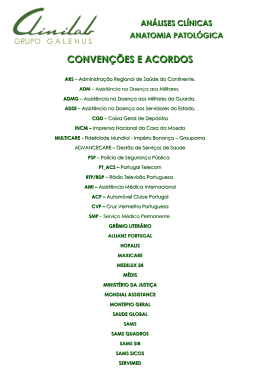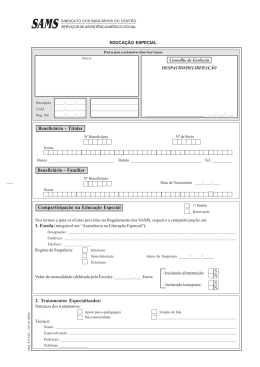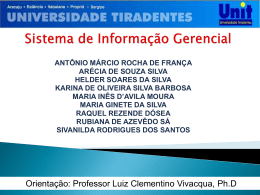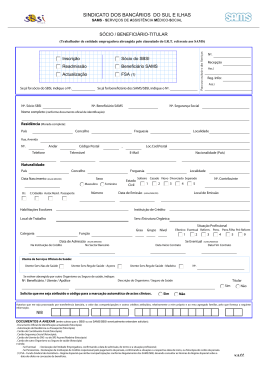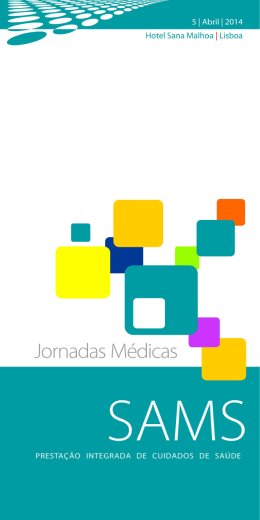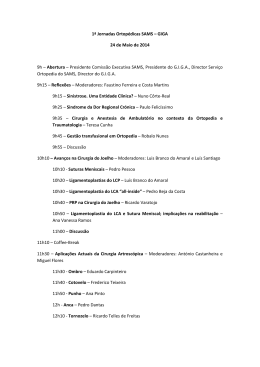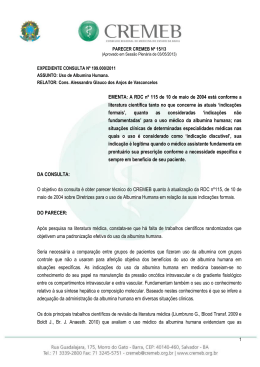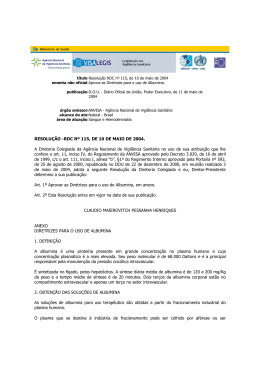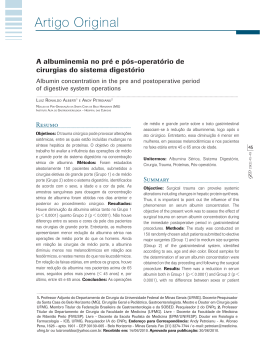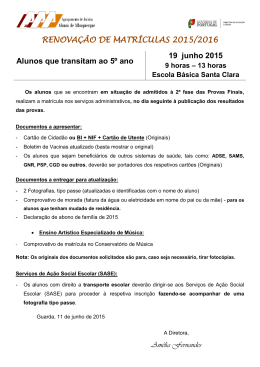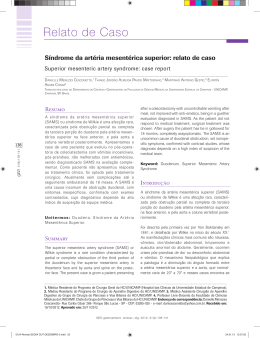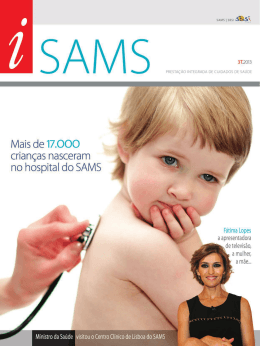Resumo A formação de trombos e o aparecimento de infecções de origem bacteriana são as principais complicações associadas à utilização de dispositivos médicos para aplicação cardiovascular. Estes fenómenos são sempre iniciados pela adsorção de certas proteínas do sangue à superfície dos biomateriais. No entanto, a albumina tem um efeito passivante, uma vez que superfícies recobertas por esta proteína apresentam maior hemocompatibilidade e baixa adesão bacteriana. O presente trabalho tem como objectivo o estudo da interacção entre proteínas do sangue e superfícies que foram quimicamente modificadas, tendo em vista o desenvolvimento de biomateriais para aplicações cardiovasculares. Durante a fase inicial deste trabalho, pretendeu-se desenvolver materiais com capacidade para induzir a adsorção da albumina, de forma selectiva, através da imobilização de um composto com grande afinidade para esta proteína - Cibacron Blue F3G-A (CB). O CB foi inicialmente imobilizado na superfície de PHEMA (poli-2-hidroxietilmetracrilato), previamente enxertado na superfície de poliuretano (PU). A imobilização do CB na superfície de PU-PHEMA proporcionou maior adsorção da albumina nesta superfície, embora não tenha aumentado a selectividade para a mesma proteína. Superfícies com albumina adsorvida apresentaram baixa adesão bacteriana, embora a superfície com CB tenha apresentado adesão bacteriana superior a PU-PREMA e a PU não modificado. Para garantir a exposição do CB à superfície, este composto foi imobilizado em superfícies modelo monocamadas auto-estruturadas (self-assembled monolayers, SAMs) - com diferentes funcionalidades químicas: dois grupos hidrofílicos (-(O-CH2CH2)4-OH e -OH) e um grupo hidrofóbico (CH3). No caso dos SAMs com gupos terminais -OH e -CH3, o CB apresenta-se destacado da superfície através de um espaçador hidrofílico. Os resultados obtidos demonstraram que a presença do CB à superfície das diferentes SAMs não aumentou a adsorção da albumina. Contudo, estudos de competição entre a albumina e o fibrinogénio nestas superfícies demonstraram que a presença do CB diminui a afinidade de SAMs terminadas em -OH para o fibrinogénio, o que sugere uma maior selectividade desta superfície para a albumina. O efeito da molhabilidade da superfície na adsorção de proteínas foi estudado utilizando SAMs preparadas com diferentes percentagens de um grupo funcional hidrofóbico e um outro hidrofílico (CH3 e -OH, respectivamente). Os grupos hidrofóbicos utilizados possuem cadeias mais longas do que os hidrofílicos. Os resultados obtidos demonstraram um aumento da adsorção de albumina com o aumento da hidrofobicidade da superfície. No entanto, ensaios de troca com outras proteínas em solução (albumina e fibrinogénio) demonstraram que nas SAMs com 65% de grupos -OH na superfície, a albumina adsorvida é facilmente trocada pela albumina em solução, mas não pelo fibrinogénio. Este resultado demonstra que foi conseguida uma maior selectividade para a albumina, ao mesmo tempo que se preservou a sua conformação. Neste trabalho a concentração das proteínas adsorvidas nas diferentes superfícies foi determinada utilizando proteínas marcadas radioactivamente. O estudo do processo de adsorção de proteínas em SAMs foi complementado pela utilização de outras técnicas analíticas, tradicionalmente utilizadas para caracterização de superfícies: medição de ângulos de contacto, IRAS (Espectroscopia de Infravermelho por Reflexão-Absorção por Transformada de Fourier), e cronopotenciometria (determinação da corrente em função do tempo, a potencial constante). Abstract Thrombus formation and infections of bacterial origin are the two major complications associated to medical devices for cardiovascular applications. These phenomena are always initiated by the adsorption of certain blood proteins at the biomaterial surface. However, albumin adsorption to surfaces has a passivation effect, since surfaces coated with this protein present increased haemocompatibility and low bacterial adhesion. The main objective of the present work is the study of the interactions between blood proteins and chemically modified surfaces, with the aim of the developing biomaterials for cardiovascular applications. During the initial part of this work, the development of materials with ability to attract and bind albumin, in a selective way was envisaged, by the immobilisation of a compound with high affinity for this protein - Cibacron Blue F3G-A (CB). CB was initially immobilised on the surface of poly(hydroxyethylmetacrylate) (PHEMA), previously graft polymerised on the surface of polyurethane (PU). The immobilisation of CB on the PU-PHEMA surface increased albumin adsorption to this surface, although it did not improve the selectivity to this protein. Surfaces pre-coated with albumin showed low bacterial adhesion, although the surface with CB showed higher bacterial adhesion than PU-PHEMA and unmodified PU. In order to assure CB exposure on the surface, this compound was immobilised in model surfaces self-assembled monolayers (SAMs) - with different chemical functionalities: two hydrophilic groups ((O(CH2CH2)4-OH and -OH) and one hydrophobic group (-CH3). In the OH- and CH3-terminated SAMs, CB is protruding from the surface through an hydrophilic spacer. Results obtained demonstrated that the presence of CB on the surface of the different SAMs did not increase albumin adsorption. However, competition studies between albumin and fibrinogen on these surfaces demonstrated that the presence of CB decreases the affinity of OH-terminated SAMs to fibrinogen on suggesting a higher selectivity of this surface to albumin. The effect of surface wettability in protein adsorption was investigated using SAMs prepared with different percentages of an hydrophobic and an hydrophilic functional group (-CH3 and -OH, respectively). The hydrophobic groups used had longer chain length than the hydrophilic ones. Results obtained demonstrated an increase in albumin adsorption with the increase of surface hydrophobicity. However, studies of exchangeability of adsorbed albumin with proteins in solution (albumin and fibrinogen) demonstrated that in the case of SAMs with 65% of -OH groups on the surface, adsorbed albumin is easily exchanged by albumin in solution but not by fibrinogen. This result shows that a higher selectivity to albumin was achieved, while maintaining its conformation. During this work, radiolabelled proteins were used to assess the concentration of protein adsorbed in all the surfaces used. The process of protein adsorption on SAMs was complemented with the utilization of other analytical techniques, traditionally used for surface characterisation: contact angle measurements, IRAS (Fourier Transform Infrared Reflection Absorption Spectroscopy), and chronopotentiometry (measurement of current as a function of time, at constant potential).
Download
